ASRock's High-End Vision 3D HTPC Reviewed
by Ganesh T S on October 3, 2010 10:20 AM EST
The Vision 3D is basically a notebook solution at its core. It wouldn't make sense to compare it with full blown Clarkdale HTPCs (or for that matter, any system with a power consumption of more than 100W). In the comparative benchmarks provided in the rest of this review, we will provide the scores obtained by the Vision 3D and other notebook solutions. Prior to those, let us look at some of the specific features of the Vision 3D.
USB 3.0 Performance
In the Core 100 review, we had pointed out the fact that the H55M chipset does not provide support for full USB 3.0 performance without a PLX bridge chip. As the Vision 3D caters to the high end market, it would have made sense for ASRock to incorporate this into the motherboard. Unfortunately, they decided to increase the number of USB 3.0 ports instead of aiming to obtain full performance from the pair of ports provided by the NEC controller.
We hooked up OCZ's Enyo 128 GB USB 3.0 external SSD (which has received glowing reviews everywhere with upto 200 MBps read and 190 MBps write speeds) to the various USB 2.0 / 3.0 ports of the Vision 3D (and also repeated the tests with the Core 100).
The OCZ Enyo on the Fresco Logic USB 3.0 Port of the Vision 3D
Using the Random Access feature of HD Tune Pro 4.50, we obtained the average read and write speeds for random sized accesses to random locations on the SSD. The performance metrics are graphed below. Note that the entries against the USB 3.0 ports of the Core 100 differ from those in the Core 100 review, because those were maximum transfer rates as opposed to the average rate presented here.
Click to enlarge
At the outset, it is clear that the USB 3.0 performance improves when compared with the Core 100. This is probably due to the faster i3-370M CPU. An additional interesting observation is that the read and write performance are very similar for the Fresco Logic port. The NEC ports excel at providing read bandwidth, but lose out to Fresco Logic on the write side. Despite these performance numbers, we feel that the third USB 3.0 port is an overkill for the Vision 3D. ASRock could have used the cost premium of this feature towards something more attractive for HTPC users like a SSD boot drive for the OS.
Windows Experience Index
The Core 100's Windows Experience Index was bottlenecked by the Arrandale iGPU. With that going out of the picture, what can hold back the performance of the Vision 3D? Let us look at the Windows Experience Index to get a general feel of the performance that a user can expect out of the machine.
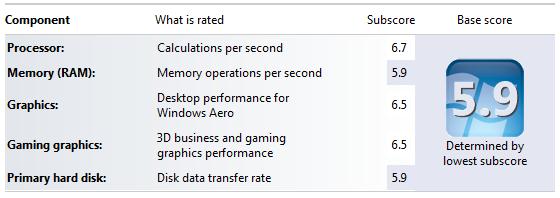
The primary hard disk and the DRAM seem to be slowing down the system. While the DRAM can be overclocked, nothing can probably be done with the primary hard disk (short of replacing it with a SSD). Unfortunately, the Scorpio Black is the fastest 500 GB 2.5" drive in the market right now, and ASRock could probably have not chosen a better drive.
Miscellaneous Performance Metrics
The graphs below give an idea of where the Vision 3D would stand from a performance perspective when compared with some popular notebook computers. PCMark Vantage's PCMark score gives a general idea of the system's capability. In addition to that, a couple of common HTPC workloads are also benchmarked. We have some data on the x264 encoding performance using the Arrandale CPU. An estimate of how well WinRAR performs, particularly with respect to processing split archives, wraps up this section. Since these are CPU-centric benchmarks, it comes as no surprise that the Vision 3D scores better than the
It can be seen from the above benchmarks that the Vision 3D loses out only to its higher clocked and higher core count cousins with respect to CPU-centric benchmarks. There is no doubt, however, that it provides better performance than the mid-range Core 100.
Starting with this review, we will add a WinRAR benchmark for HTPCs. While there is a built-in benchmark to measure the compression speed, it relies on the capabilities of the CPU, DRAM and caches only. Many HTPC users also spend quite some time decompressing split archives. To evaluate this, we take a 4.36 GB MKV file, compress it in the 'Best' compression mode into a split archive (97.1 MB each), which results in 44 files on the hard disk. The time taken to decompress this split archive is then recorded. The performance in this benchmark is heavily influenced by the hard disk in the system. While both the Core 100 and Vision 3D scored similar results in the built-in benchmark (1525 KBps for the Vision 3D and 1452 KBps for the Core 100), the former took 329 seconds to process the split archive, while the latter only took 173 seconds for the same. Starting with the next HTPC review, we will be presenting comparative results for this benchmark in the form of a graph.
In the next couple of sections, we will look at some GPU benchmarks.


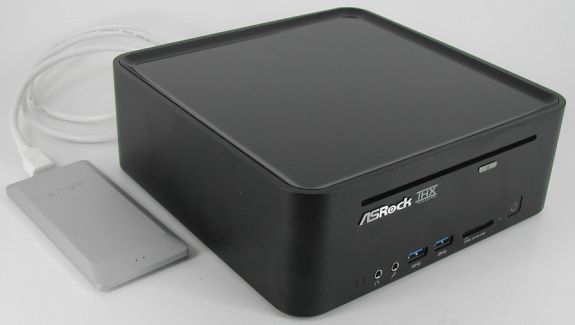
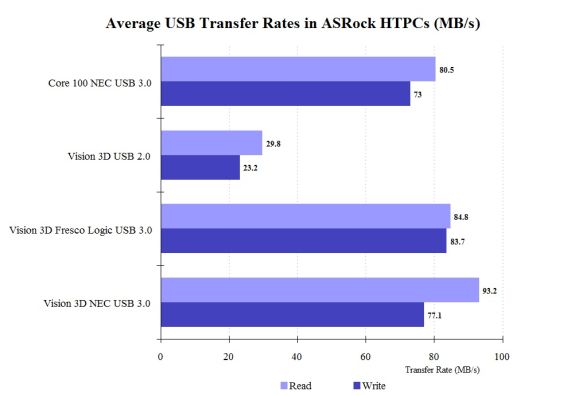
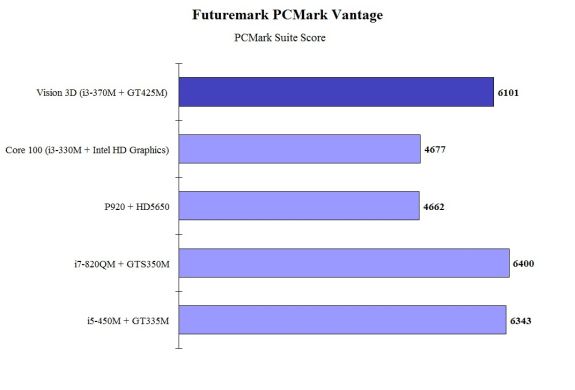
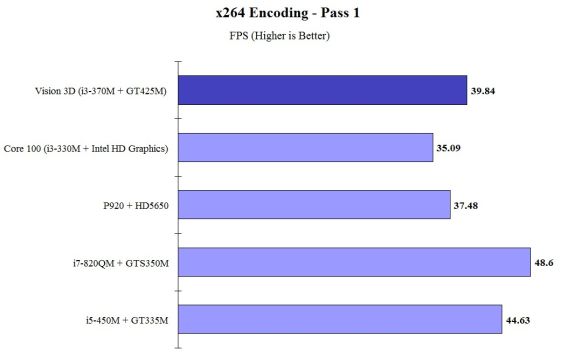
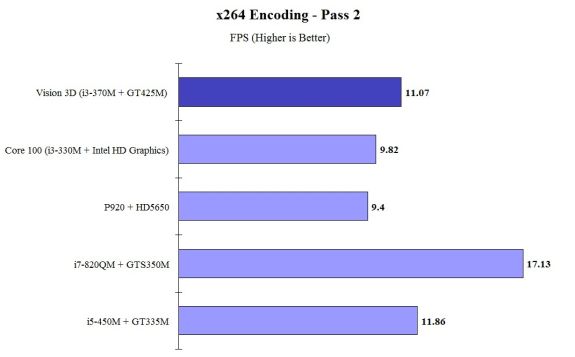








51 Comments
View All Comments
ProDigit - Sunday, October 3, 2010 - link
Looks interesting at first, but I don't much like nvidia graphics cards, and the WD drive.WD drives are known to break right after their warranty expires when using them a lot.
The only good about the nvidia card is that it could be set up to work with CUDA (CPU + GPU in parrallel); although cuda now also supports most ATI/AMD cards.
The price of this setup is quite on the high end. If it wasn't for 3D vision, I'd say this computer would go for no more than $699. With 3D, I'd say $799 max.
I personally don't care if it supports 3D or not, since I have no monitors that support this resolution. So for me it's only worth $599.
ProDigit - Sunday, October 3, 2010 - link
They should have gone with a Toshiba drive instead. Yes, WD has faster continuous write and read speeds, but Toshiba is much better in IO performance.An OS like Windows 7 would boot faster with Toshiba, than with WD, and would run significantly cooler too!
WD is absolutely NOT the best drive they could have chosen! The cheapest perhaps yes.
ganeshts - Sunday, October 3, 2010 - link
Looks like the WD Scorpio Black is as good as the Momentus XT from Seagate (except for the Disk Capture benchmark):http://www.storagereview.com/western_digital_scorp...
So, from a price-performance ratio, it makes sense to go with WD.
I have also mentioned in my review that a mini-PCIE SSD for the boot drive would have been good :)
sprockkets - Sunday, October 3, 2010 - link
The best notebook drives were made by IBM, and now Hitachi. Whether that still is the case, who knows.Zok - Sunday, October 3, 2010 - link
CUDA is not supported on ATI/AMD cards. DirectCompute and OpenCL are, however, supported by both.LtGoonRush - Sunday, October 3, 2010 - link
Studies of both operating disk populations and drives sent in for data recovery show that no brand of drives is measurably more or less reliable than others, with the notable exception of the Seagate model ranges affected by their firmware bugs. It's also been conclusively proven that drive usage doesn't affect failure rates; lightly loaded and heavily loaded drives fail at the same rate. It's true that a failing drive will have its death hastened by heavy load, but you shouldn't be using a drive that's failing anyway, it should be replaced with the first SMART error it logs. The WD Scorpio Black drives in particular are the fastest notebook HDDs available, balancing high throughput with excellent seek times (Seagate drives have always had abysmal seek performance). It's also a little silly to complain about heat when we're talking about drives with sub-4W PEAK power draw.chrnochime - Sunday, October 3, 2010 - link
great job for correcting him without making it more obvious how wrong he is. I would've not sugarcoat it as much as you did though heh.lexluthermiester - Sunday, October 3, 2010 - link
Seriously? Not liking Nvidia, well that is just personal preference. You not having a TV/Monitor that supports what this system can put out is not the fault of the maker or the system itself, it your problem. But bashing WD? They make the finest hard drives in the world and there are certainly worse hard drive makers. Now I'm not going to be low class and name names, but really? And if you don't like this little system, then don't buy it, but don't bash something that certainly has usefulness to a certain audience of users and at a very fair price.Parhel - Sunday, October 3, 2010 - link
False. WD drives are not "known" for high failure rates. All drive manufacturers compare about evenly in most areas. WD is one of, if not the, best choice out there.Samus - Sunday, October 3, 2010 - link
I was a WD fan in the 90's and after the 7200.7's came out and they ditch the wetsuits I became a die-hard Seagate fan because of the 7200.7's legendary reliability, low cost, 5-year warranty and 'decent' performance. These were all big selling points during an era where the Deathstar 75GXP rocked the storage industry with what some circles were calling a "definitive" failure rate within the warranty period.The Seagate drives just worked. However, recently I've had a lot of Seagate 7200.10 and 7200.11 drives giving me SMART errors, specifically reallocated sector counts. They also run hot compared to my new WD Blue 1TB drive and they're all mounted in the same cage. A few years ago I had a 1.5TB Seagate I had to flash to CC1G because of the firmware 'recall' which was definitely a quality control concern. I didn't loose data, but I know somebody who did, one day their drive was just blank. We flashed the firmware and his data was back, but the drive failed after a few months without warning, just spun up and clicked. Tried freezing it. No dice.
Seems like WD is taking the quality/reliability crown, where as they've always had the performance crown...but performance wasn't as important to me as making sure the drive would work for 3-5 years without any issues.
I'd consider a Hitachi in the future, but will probably continue to stick with Seagate and WD drives. Considering how many dead Samsung and Fujitsu drives I've pulled and replaced from friends' desktop and laptop's over the years, it's a no-brainier to stay the hell away from those. Toshiba I have mixed feelings about because over the past 20-years, I just didn't care much for their laptops. Hypocritically, I love Thinkpad's but when IBM had those 75GXP failures, I didn't change my mind about their laptops, and still think they make the best laptop's out there. Ironically things are different now, because Hitachi makes the hard drives and Lenovo makes the Thinkpad's. IBM has little to do with either now.